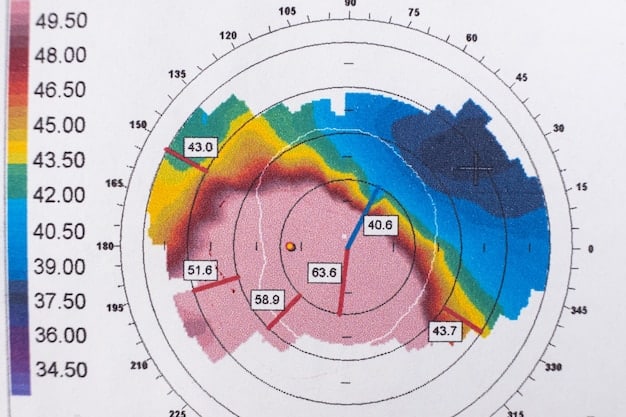Energy Management: Boost Productivity by 20% Optimizing Peak Times

Energy management for productivity involves aligning tasks with your natural energy peaks, potentially increasing output by 20% through strategic scheduling and self-awareness of your most and least energetic times.
Feeling drained and unproductive? Discover how energy management: optimize your day based on peak performance times for a 20% productivity increase can transform your workflow and help you achieve more with less stress.
Understanding Your Energy Rhythms
Everyone experiences natural fluctuations in energy levels throughout the day. Recognizing these rhythms is crucial for effective energy management.
By understanding when you are naturally more alert and focused, you can strategically schedule tasks to maximize your productivity.
Identify Your Peak Performance Times
Your peak performance times are when you feel most energized and focused. These periods are ideal for tackling your most demanding tasks.
Recognize Your Energy Dips
Conversely, recognizing your energy dips helps you avoid scheduling critical tasks during these periods, preventing burnout and reduced effectiveness.
- Track your energy levels throughout the day using a journal or app.
- Note any patterns or triggers that influence your energy.
- Experiment with different scheduling strategies to align tasks with your peak times.
- Adjust your schedule based on your findings for optimal productivity.
Understanding your energy rhythms is the foundation of effective energy management, enabling better task allocation and sustained productivity throughout the day.
The Science Behind Energy Management
Effective energy management is rooted in scientific principles that explain how our bodies and minds function throughout the day.
These principles highlight the importance of understanding and leveraging natural rhythms to optimize performance.

Circadian Rhythms and Productivity
Circadian rhythms, our internal body clocks, regulate various physiological processes, including energy levels. Understanding these rhythms can greatly enhance productivity.
The Role of Hormones
Hormones like cortisol and melatonin play a significant role in our energy levels. Managing these hormonal fluctuations can lead to more consistent performance.
- Cortisol levels are typically highest in the morning, promoting alertness.
- Melatonin levels increase in the evening, preparing the body for sleep.
- Disruptions to these hormonal cycles can lead to fatigue and decreased productivity.
- Strategies such as regular sleep schedules and exposure to natural light can help regulate these hormones.
The scientific foundation of energy management provides a clear understanding of how to optimize daily routines for peak performance and sustained productivity.
Creating a Personalized Energy Management Plan
Developing a personalized energy management plan involves tailoring strategies to your specific needs and lifestyle.
This approach ensures that you are working in harmony with your natural rhythms, maximizing your effectiveness and well-being.
Assess Your Current Routine
Begin by evaluating your current daily routine to identify areas where you can better align tasks with your energy levels.
Set Realistic Goals
Establish achievable goals for incorporating energy management techniques into your daily life, focusing on gradual improvements.
- Identify your peak performance times and schedule your most demanding tasks accordingly.
- Allocate less critical tasks to periods of lower energy.
- Incorporate short breaks throughout the day to prevent burnout.
- Adjust your plan based on ongoing evaluations and feedback for optimal effectiveness.
A personalized energy management plan is a flexible tool that adapts to your unique circumstances, fostering a more productive and balanced lifestyle.
Practical Techniques for Boosting Energy Levels
Several practical techniques can help boost your energy levels throughout the day, enhancing your productivity and overall well-being.
These strategies focus on simple yet effective ways to manage your energy and maintain focus.

Nutrition and Hydration
Maintaining a balanced diet and staying properly hydrated are essential for sustained energy levels.
Regular Exercise
Incorporating regular physical activity into your routine can significantly boost your energy and focus.
- Choose nutrient-rich foods that provide sustained energy, such as fruits, vegetables, and whole grains.
- Avoid sugary snacks and processed foods that lead to energy crashes.
- Stay hydrated by drinking water throughout the day.
- Aim for at least 30 minutes of moderate exercise most days of the week for increased energy and focus.
Implementing these practical techniques can lead to noticeable improvements in your energy levels and productivity, promoting a more energized and focused lifestyle.
Overcoming Common Energy Management Challenges
Implementing an energy management plan can come with its own set of challenges. Recognizing and addressing these obstacles is crucial for long-term success.
Strategies for coping with these challenges can help maintain consistency and effectiveness.
Dealing with Unexpected Energy Dips
Develop strategies for managing sudden drops in energy, such as taking short breaks or engaging in light physical activity.
Staying Consistent with Your Plan
Maintaining consistency requires discipline and adaptability. Continually assess and adjust your plan to fit changing circumstances.
- Identify and eliminate energy-draining activities or habits.
- Build accountability by sharing your plan with a friend or colleague.
- Reward yourself for achieving milestones to stay motivated.
- Regularly reassess your plan and make adjustments as needed to overcome challenges.
By proactively addressing these challenges, you can maintain the effectiveness of your energy management plan and continue to optimize your productivity.
Measuring the Impact of Energy Management
To determine the effectiveness of your energy management plan, it’s essential to track and measure its impact on your productivity.
Metrics and feedback can provide valuable insights into what’s working and what needs adjustment.
Tracking Productivity Metrics
Monitor key performance indicators (KPIs) to assess how energy management influences your output and efficiency.
Gathering Feedback and Adjustments
Regularly solicit feedback from yourself and others to fine-tune your plan for optimal results.
- Use tools such as time-tracking apps, task management software, and productivity journals to monitor your progress.
- Compare your productivity levels before and after implementing energy management techniques.
- Seek input from colleagues, friends, or mentors to gain different perspectives.
- Adjust your schedule and strategies based on the feedback you receive to maximize effectiveness.
Measuring the impact of energy management allows you to refine your approach and ensure that you are continuously improving your productivity and well-being.
| Key Point | Brief Description |
|---|---|
| ⚡ Peak Performance Times | Identify and utilize your most energetic periods for demanding tasks. |
| ☕ Nutrition & Hydration | Maintain energy levels with balanced diets and consistent hydration. |
| 💪 Regular Exercise | Incorporate physical activity to boost energy and concentration. |
| 😴 Consistent Sleep | Ensure regular sleep patterns to regulate hormones and energy levels. |
Frequently Asked Questions
▼
Energy management involves understanding your natural energy rhythms to strategically schedule tasks. It’s important because it enhances productivity by aligning tasks with your peak performance times, leading to greater efficiency.
▼
Track your energy levels throughout the day using a journal or app. Note when you feel most alert and focused. Recognizing these patterns helps you schedule tasks based on your natural energy cycles.
▼
Practical techniques include maintaining a balanced diet, staying hydrated, incorporating regular exercise, and ensuring consistent sleep patterns. These habits contribute to sustained energy levels throughout the day.
▼
Circadian rhythms regulate various physiological processes, including energy levels. Understanding and aligning with these rhythms can optimize productivity by scheduling tasks when you’re naturally more alert and focused.
▼
If you experience an unexpected energy dip, take a short break to recharge. Engage in light physical activity, such as stretching or a brief walk, or switch to a less demanding task until your energy returns.
Conclusion
By implementing effective energy management strategies, you can optimize your day to align with your peak performance times, potentially increasing your productivity by 20% and achieving a more balanced and fulfilling lifestyle.





